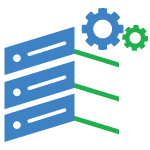Why is Magento The Best for Ecommerce Sites? Magento 2.4.0 Hosting Recommendation. In this article, we will discuss why is Magento the best for e-commerce sites and who is Magento 2.4.0 hosting recommendation.
Why is Magento The Best for Ecommerce Sites?

One company’s experience with Magento is likely to be totally different than another’s because Magento is really what you make it. A team of highly skilled designers and web developers can make Magento into the Cadillac (or Maserati) of websites, but a poorly done ‘botched theme-job’ could leave you struggling with a site that looks like rubbish.
To get the most out of Magento you’ll want to engage with a company that is serious about SEO and Conversion Rate Optimization. To start you’ll want a site that has a place to update content regularly or that integrates with an outside blogging platform for regular content updates. You’ll want that blog to live at YourStore.com/blog and look very similar to the rest of your site however you do it, rather than blog.YourStore.com and looking like a totally different site. This ensures your blog content not only attracts potential customers but facilitates them around the site as seamlessly as possible without giving them a jarring effect.
“Everyone uses it”
Yes, we know that this argument may lead to false conclusions. It well may be that something is agreed on by the majority while it is not necessarily the best option.
But now we are talking about ecommerce and business results.
Magento is the second most popular ecommerce platform: it has a market share of 17%, among the Top 100k sites (Magento CE and Magento Enterprise combined, July 2017).
Professional technological support and huge knowledge base
The IT developers of Magento eCommerce, thanks to the help of volunteers, have been able to create a platform that truly serves the unique needs of users.
The flexibility and openness of the system is basically the result of this philosophy. A couple of years ago Magento was acquired by eBay.
This did not come as a disadvantage: it stayed to be an open source platform, while it also enjoyed the massive amount of expertise of the huge ecommerce company.
Magento Commerce then got independent of eBay, but its extremely strong and loyal developer community, which had evolved well before its acquisition by eBay, is still passionately working on its development.
Huge array of product information
It is no surprise that Magento is so popular: it is the most widely used ecommerce platform (according to 2015 statistics) in the world with a nearly 30% market share. Serving such a big chunk of the market successfully would be impossible without a massive amount of flexibility.
You can define basically any product feature you like.
You can set and manage the attributes without compromise in the admin panel. Basically, you can adjust the entire system to your products.
The discount system is equally flexible. For instance, you can give a discount (e.g. a percentage of the price or free shipping) to a particular shopper if he or she puts two products from the same category into the shopping cart. You can define a whole bunch of combinations, you have loads of opportunities to do whatever you like.
Impressive, responsive design
Needless to say that you can tailor the look of your Magento store according to your expectations. It simply could not be any other way, since a standard template would not add very much to your brand value.
It is not a problem if you are not an expert in web design, for Magento offers thousands of freely customizable templates. Installation, however, is recommended to be performed by a specialist.
Responsive design is even more important. There are many solutions on the market that have “forgotten” to adapt to the most recent market needs. Since 2014, more and more people use the internet on their tablets and smartphones, and an increasing proportion of purchases are done on mobile devices.
An online store can compete in such an environment successfully if it has a responsive layout, which means that it offers an interface to its shoppers, which is easy to handle on all platforms from tablets and smartphones to PCs and netbooks.
Supports SEO
Magento features a range of default options to create an SEO-friendly website. You can generate SEO-friendly URLs and sitemaps (e.g. yourdomainname.com/productname), can define the meta data and so on. Searches within your e-store is also crucial, which is also a major strength of Magento.
Customers make multiple, narrow-down searches, which is good for user experience, but less beneficial for SEO because this makes the system generate new product lists or new pages after the searches have been made, but can be regarded as duplicate content by Google.
This drawback can be handled by custom development. The developers of Magento have always kept in mind that Magento websites should be easily found and stay strong in terms of SEO.
Magento is secure
Safety is not an option, it is a must in an environment where hackers try to crack databases every minute. We hear news almost every day mentioning data breaches, so in case of an ecommerce store it is essential to have a hack-proof system.
Luckily, Magento is always tested by a vast number of developers.
The whole system is constantly watched by experts (e.g. ethical hackers) searching for defects and eliminating vulnerability by uploading patches.
But don’t worry, you don’t have to hunt down updates all the time. Magento always calls your attention when an update is available so you will know about fresh developments right away. (You had better ask an expert to carry out the update process, especially when you already have some custom developments in your store.)
All in all, the system is not perfect. No system is. But with Magento it is just amazing how fast its dedicated community can reveal the errors and after making the safety updates, you can avoid any future problems before they can kick in.
Data!
Even if you only have a little experience in online marketing, you very likely know that this business is based on data.
No matter what kind of a website you run, if you want to earn money with it, you need to build databases and after examining them, draw the appropriate conclusions.
You have to know how many visitors you have, how they find you, how much time they spend on your pages etc.
There are a lot of factors you should keep an eye on so that you can optimize your website according to user behaviour and preferences.
You can integrate one of the most useful data collection systems, Google Universal Analytics, into your Magento website.
An even better solution can be implementing Enhanced Ecommerce, specially developed for ecommerce systems. Applying this extension for Analytics needs some programming, but it provides much more detailed data.
Thus you can collect a huge amount of useful data about your shoppers, such as what they like or how they behave when browsing in your store. You also have to watch and control the system. You should know how your website performs, how it works, what may cause failures.
Thanks to the tools of Magento support, you will receive comprehensive reports from which experts can easily find the reasons for malfunctioning.
If you have the possibility, it is worth to request an automated testing system service from your developer partner, which may raise problem solving to a whole new level.
Complete ecommerce toolkit
- Shopping Cart: Magento can comfortably lead the customers through the whole shopping process. It can be either used by registered users or guests and can also offer multiple payment options.
- User Account: Shoppers can quickly access their purchase history, check their orders or save products that they want to buy later. In addition, they can store information so that next time they can check out faster. Such information can be delivery address or invoicing address which the users can switch with only one click if they wish to.
- Management: You can manage transactions in the admin panel, start and complete the shipping process or resolve complaints. A top list can be downloaded about the most searched products (exact terms of what your customers typed in the search field), about the most popular products, or you can see if a particular shopper put some items in his or her shopping cart, but did not order them.
- Product Management: You can import and export thousands of products and modify their attributes at the same time, you can upload images, set custom pricing conditions, and determine what to show and how to show them in your “shop window”.
- Marketing: You can run promotions, create unique sales deals, offer free shipping or other special bargains. You also have opportunities for up-selling and cross-selling, you can preset opinions about or comparisons between products, display lists of recently viewed items, and also make it possible for shoppers to share your product pages easily and quickly with each other on social networking sites.
- Multiple websites: Magento is capable of handling more, an almost unlimited number (!) of websites simultaneously. You can run multiple iterations at the same time with only one user account so managing all these is much simpler. What does it mean more precisely? Say, you have a central online store with a dozen brands. You also have separate e-stores for each brand, all independent from the main website, where you can define different prices and discount offers―and you can manage all this in one single admin area.
Better than anyone – you know what the needs you have for your eCommerce store are – it would be wise to get a master list of these and determine which eCommerce platform lives up to your list before going to a web development shop. If you try to work with a web development company too early, you might find yourself being advised towards a particular solution that doesn’t actually fulfill everything your company needs, because it is what that web development shop is best at.
No web development shop can be the experts in every Content Management System – and it’s actually best if you find a company that is actually specialized in the particular CMS you have a need for. So to recap – these 3 key steps should be taken before you choose an agency:
- Write out a list of needs of your eCommerce platform to facilitate your online sales goals – both absolutely needs and non-negotiables.
- Do research on which CMS’s are the best possible solution for your specific needs and which would be most effective as accomplishing the job for the money.
- Search out and find agencies that have clear examples of using this technology in their portfolio – and contact the top 3-5 to start conversations. Narrow them down as soon as you are able and create a serious discussion where you can determine if you can get what you need done for you budget and if the companies can work together from a ‘cultural-fit’ perspective.
What’s New in Magento 2.4.0?
Highlights
Look for the following highlights in this release:
Substantial security enhancements
This release includes over 30 security fixes and platform security improvements.
Over 30 security enhancements that help close remote code execution (RCE) and cross-site scripting (XSS) vulnerabilities
No confirmed attacks related to these issues have occurred to date. However, certain vulnerabilities can potentially be exploited to access customer information or take over administrator sessions. Most of these issues require that an attacker first obtains access to the Admin. As a result, we remind you to take all necessary steps to protect your Admin, including but not limited to these efforts: IP allowlisting, two-factor authentication, use of a VPN, the use of a unique location rather than /admin, and good password hygiene.
Additional security enhancements
- Implementation of 2FA for Admin accounts, Magento.com user accounts, and Cloud SSH access
- Securing your Magento Admin account. Two-factor authentication (2FA) is now required for the Magento Admin. Admin users must first configure their 2FA before logging into the Admin through either the UI or a web API. 2FA is enabled by default and cannot be disabled. This extra step of authentication makes it harder for malicious users to log in to the Admin without authorization.
- Securing your Magento account. Two-factor Authentication (2FA) provides an added, optional layer of security to better protect your Magento.com account from unauthorized users who might want to use your account in ways you do not want.
- Securing Cloud SSH access. Magento Commerce Cloud provides multi-factor authentication (MFA) enforcement to manage authentication requirements for SSH access to Cloud environments. Multi-factor authentication for 2FA is not enabled by default on a project. Magento highly recommends enabling this feature. Contact Support for assistance.
- Template filter strict mode is now enabled by default. Magento components (including CMS pages and blocks) that use the template filter in legacy mode can be vulnerable to remote code execution (RCE). Enabling strict mode by default ensures that RCE attacks cannot be deliberately enabled.
- Data rendering for UI data providers is now disabled by default. This removes an opportunity for malicious users to execute arbitrary JavaScript.
- New
\Magento\Framework\Escaperclass. This class is provided for.phtmltemplates and the PHP classes that are responsible for generating HTML. This class contains HTML sanitization methods relevant to multiple contexts. The$escaperlocal variable is available inside.phtmltemplates and should be used instead of the deprecated$block->escape{method}. Use$escaperrather than$blockas the use of$block->escape{method}has been deprecated. - Support for new security.txt file. This file is an industry-standard file on the server that helps security researchers report potential security issues to site administrators.
Starting with the release of Magento Commerce 2.3.2, Magento will assign and publish indexed Common Vulnerabilities and Exposures (CVE) numbers with each security bug reported to us by external parties. This allows users of Magento Commerce to more easily identify unaddressed vulnerabilities in their deployment. You can learn more about CVE identifiers at CVE.
Platform upgrades
The following platform upgrades help enhance website security and performance. Supported versions of PHP and PHPUnit, Elasticsearch, MySQL, and other dependencies are listed in Magento 2.4 technology stack requirements.
- PHP 7.4 support introduced and PHP 7.1 and 7.2 deprecated. Magento 2.4.0 introduces support for PHP 7.4.
- Support for PHPUnit 9.x and deprecation of PHPUnit 6.5. PHP 7.4 requires the use of the latest PHPUnit testing framework, which is PHPUnit 9.x. Magento Marketplace extension vendors must confirm that all new extension versions are compatible with PHP 7.4 and that all unit and integration tests have been configured to be run with PHPUnit 9.
- Elasticsearch 7.6.x support. Elasticsearch 7.6.x is now the default catalog search engine for Magento Commerce and Open Source. You cannot install or upgrade to Magento 2.4.0 without also installing Elasticsearch 7.6.x. Elasticsearch version 2.x code has been removed. Elasticsearch versions 5.x and 6.x have been deprecated and are no longer supported.
- MySQL 8.0 support. Magento 2.4.x supports MySQL 8.x. (Magento 2.4.0 was tested with MySQL 8.0.20.) Merchants are encouraged to migrate their deployments to MySQL 8.x to take advantage of its improved performance, security, and reliability. Although MySQL 5.7 is still supported for Magento 2.4.x, MySQL 5.6 is no longer supported. You cannot host Magento 2.4.x with a MySQL 5.6 database.
- Removal of the MySQL catalog search engine. The MySQL search engine has been removed from Magento 2.4.0 and replaced as the default search engine with Elasticsearch. Elasticsearch provides superior search capabilities as well as catalog performance optimizations. All merchants must have Elasticsearch to install and deploy Magento 2.4.0.
- MariaDB 10.4 support. Support for MySQL 8.0 provides the opportunity for merchants to deploy MariaDB 10.4 with Magento. Although merchants can still use MariaDB 10.2 with Magento 2.4.0, we recommend upgrading to MariaDB 10.4 for improved performance and reliability. MariaDB 10.0 and 10.1 are no longer supported (as a result of removing support for MySQL 5.6 in this release).
- Migration of dependencies on Zend Framework to the Laminas project to reflect the transitioning of Zend Framework to the Linux Foundation’s Laminas Project. Zend Framework has been deprecated.
- Decomposition of Magento Controllers allows extension developers to implement ActionInterface directly without “layer supertype” classes. Enhancement started by Vinai Kopp in pull request 16268 and finalized by Lukasz Bajsarowicz in pull request 26778. GitHub-9582
- Removal of the core integration of the Signifyd fraud protection code. This core feature is no longer supported. Merchants should migrate to the Signifyd Fraud & Chargeback Protection extension that is available on the Magento Marketplace.
- The core Braintree module has been removed from the code base. The Braintree Payments module now provides the same feature set.
Infrastructure improvements
This release contains enhancements to core quality, which improve the quality of the Framework and these modules: Customer Account, Catalog, CMS, Import, Cart and Checkout, and B2B.
- Removal of core integration of third-party payment methods. With this release, the Authorize.Net payment method integration has been removed from core code. Merchants should migrate to the official extension that is available on the Magento Marketplace.
- Support for partial-word search for Elasticsearch (new default search engine). Elasticsearch now supports the use of partial words in search terms for product names and SKUs when using quick search. This capability was supported by the MySQL search engine, which has been deprecated and replaced by Elasticsearch in this release.
- PayPal JavaScript SDK upgrade. We’ve migrated the PayPal Express Checkout integration to the latest PayPal JavaScript SDK, an SDK that automatically collects and passes needed risk parameters to PayPal. The behavior of the PayPal Express Checkout payment method remains unchanged. However, upgrading this SDK to the latest version let merchants access the latest features and security enhancements.
- Deprecation and removal of the Web Set Up Wizard. You must use the command line to install or upgrade Magento 2.4.0.
- Composer update plugin. Composer plugin streamlines the upgrade process by resolving changes that must be made to the root project
composer.jsonfile before updating to a new Magento product requirement. This plug-in protects against overwriting customizations. - Seller-assisted shopping. This feature allows merchants to view the storefront on behalf of their customers. Customers opt to allow storefront access to their accounts. This community-developed feature includes an original extension developed by MAGEFAN. Features include:
- ACL to control which administrators can log in to customer accounts can be configured on a per-website basis
- Compatibility with multiple websites and customer account scopes
- Orders placed on behalf of customers are logged in the storefront and Admin
- All sessions are destroyed following administrator logout, and administrators cannot access customer passwords.
Performance improvements
- Improvements to customer data section invalidation logic. This release introduces a new way of invalidating all customer sections data that avoids a known issue with local storage when custom
sections.xmlinvalidations are active. (Previously, private content (local storage) was not correctly populated when you had a custom etc/frontend/sections.xml with action invalidations.)- Decrease in the size of network data transfers between Redis and Magento
- Reduction in Redis’ consumption of CPU cycles by improving the adapter’s ability to automatically determine what needs to be loaded
- Reduction in race conditions on Redis write operationsMultiple optimizations to Redis performance. The enhancements minimize the number of queries to Redis that are performed on each Magento request. These optimizations include:
- Improved caching of results of SQL queries to inventory tables. These enhancements include:
- Caching of SQL queries to the
inventory_stock_sales_channeltable (1 query instead of 16) - Caching of result of queries to the
inventory_stocktable (1 query instead of 16)
- Caching of SQL queries to the
- Improvement of up to 25-30% to Quick Order add-to-cart performance.
- Merchants can now use lazy loading to load images.
Adobe Stock Integration v2.0
Ability to license stock image previews from the Media Gallery. Merchants can now find any Adobe Stock preview image in the Media Gallery, which reduces the number of steps required to license stock preview image.
New Media Gallery
This replacement for the former Media Gallery offers a new, searchable interface for Magento media assets. Administrators can now search, filter, and sort images up to 30x faster than they could in the earlier version of this feature. Merchants can use this tool to evaluate storefront image usage. Extension developers should be aware that extensions that were developed for the Media Gallery will not work as expected with the new Media Gallery.
Inventory Management
Inventory Management enhancements for this release include support for in-store pickup and bundle product support.
GraphQL
GraphQL enhancements include:
pickupLocationsquery supports the Inventory In-store pickup featurecategoriesquery returns a list of categories that match a specified filter. This query differs from thecategoryListquery in that it supports pagination.reorderItemsmutation allows a logged-in user to add all the products from a previous order into their cart.
PWA Studio
See Magento compatibility for a list of PWA Studio versions and their compatible Magento core versions.
Magento Functional Testing Framework (MFTF)
MFTF v3.0.0 includes these new features and includes support for PHP 7.4 and PHPUnit 9:
- MFTF helpers, which can create custom actions outside of the test framework
- schema updates for test entities
- sub-folders in test modules
- nested assertion syntax
- static check that checks and reports references to deprecated test entities
This release also removes deprecated actions and upgrades scripts that were added to upgrade tests to MFTF major version requirements.
Vendor-developed extension enhancements
This release of Magento includes extensions developed by third-party vendors. It introduces both quality and UX improvements to these extensions and an expansion of MFTF coverage.
Magento Marketplace extension vendors should confirm that their extensions are compatible with PHP 7.4 when publishing a new version of their extension for Magento 2.4.0.
Amazon Pay
This release includes:
- Updates to CSP allowlists
- Ability to do multiple authorizations for a multi-item order
- Support for Japanese addresses
Braintree Payments
This extension replaces our core Braintree integration. It provides the same features as the Braintree core integration.
Klarna
This release includes new on-site messaging options to help shoppers understand the available credit and financing options. It also includes improvements to:
- refunds
- API efficiency
- cookies and unit tests
- discounts
- configuration settings now contain On-Site Messaging section for the control of the storefront display of Klarna promotional messaging.
Vertex
This release of Vertex includes the following new feature and enhancements:
- Improvements to the Admin configuration user experience
- Replacement of installation and upgrade scripts with XML schema files and patches
- Removal of deprecated code (
ApiClientandClientInterface)
Yotpo
Yotpo Ratings and Reviews are integrated with Page Builder.
Magento 2.4.0 Major Features:
- Get AI Integrated Magento Commerce to Drive Sales More Efficiently

With the best feature release, the integration of Adobe Sensei where the merchants will get more benefits for new product recommendations to the customers in their Magento 2 Store, and with the help of this, the customer enhancement will be improved which will result in the overall sales growth.
- Drag & Drop Page Builder Templates for Better Content Creation

Now, merchants are enhanced with the Drag & Drop Page Builder Templates for Better Content Creation which will be very less time consuming and will increase more attraction of customers towards the store. With the use of all the page builder templates, there will be a facility to create new pages very fast and also there is no requirement to build the content pages from scratch. If any circumstances arise like the current circumstance of COVID-19 then the merchants are capable of building the new pages using the templates and let their users be informed about the status of the store.
- New Design Experience with New UI

With the new update, there are new designs introduced by Magento. Especially for creating your store elegant and with the help of new designs the customer experience on your store will get improved and also the UI is appreciable where your store can get some rich attractive look.
- Get Free Amazon sales channel extension that works faster onboarding process

The very effective and powerful extension developed where the Magento retailers are capable to sell the products in the Amazon marketplace wherein advancement to that the increase in connecting your Magento 2 store on Amazon made it easier.
With an increase in functionality, there is also an advanced add-on by providing the Amazon sales channel dashboard.
Substantial security enhancements:
The Substantial security enhancements in this release include more than 25 security enhancements that will be very helpful to close the cross-site scripting (XSS) and also the remote code execution (RCE) vulnerabilities. There are no attack issues that came over till now and many of the weak points are taken out from where the access of customer details can be found. The main reason to attack is that the attacker directly attacks the Admin and from there all other issues are started so there is open advice to secure your admin. All the known security issues are already resolved by the release of Magento 2.4.0.
Magento 2.4.0 Hosting Recommendation
Magento is a feature-rich, professional open-source eCommerce solution that offers merchants complete flexibility and control over the look, content, and functionality of their online store. Features includes powerful marketing, merchandising and content management. Magento is designed for scalability and is backed by an extensive support network.
Are you looking for Magento 2.4.0 Hosting Recommendation? Finding a high quality Cheap Magento 2.4.0 Hosting provider is crucial for your web application. Your Magento 2.4.0 application can only run smooth if it will be hosted on a server which can provide a higher up time & plenty of computing resources. There’re thousands of web hosting providers which offer asp.net hosting, but choosing Magento 2.4.0 Hosting Recommendation provider is a time consuming task. To make your buying decision easy we’ve concluded 3 Best yet Cheap Magento 2.4.0 Hosting providers which are reliable and offer affordable Magento 2.4.0 Hosting so that every one can afford it.
Magento 2.4.0 Hosting Recommendation
|
|
|
|
|---|---|---|
| ASPHostPortal | DiscountService.biz | UKWindowsHostASP.NET |
| $1.00/month | $2.00/month | £3.00/month |
| Host 1 Site | Host 1 Site | Host 5 Sites |
| 1 GB Disk Space | 1 GB Disk Space | 1 GB Disk Space |
| 10 GB Bandwidth | 10 GB Bandwidth | 20 GB Bandwidth |
| Dedicated Application Pool | Dedicated Application Pool | Dedicated Application Pool |
| Support UTF-8 Domains | Support UTF-8 Domains | Support UTF-8 Domains |
| 30-Days Money Back | 30-Days Money Back | 30-Days Money Back |
| Latest ASP.NET | Latest ASP.NET | Latest ASP.NET |
| Plesk Control Panel | Plesk Control Panel | Plesk Control Panel |
| Windows 2008/2012 | Windows 2008/2012 | Windows 2008/2012 |
| SQL Server 2008/2012/2014 | SQL Server 2008/2012/2014 | SQL Server 2008/2012/2014 |
| Latest MySql version | Latest MySql version | Latest MySql version |








